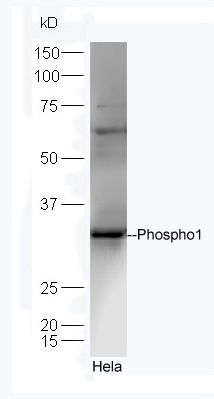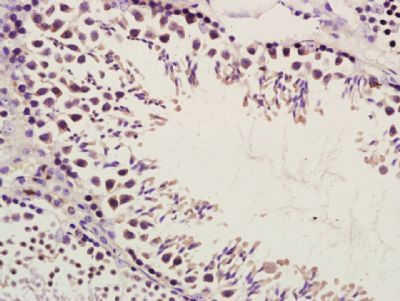Phospho1 Polyclonal Antibody
Purified Rabbit Polyclonal Antibody (Pab)
- SPECIFICATION
- CITATIONS
- PROTOCOLS
- BACKGROUND

Application
| WB, IHC-P, IHC-F, IF, ICC, E |
|---|---|
| Primary Accession | Q8TCT1 |
| Reactivity | Rat, Pig, Dog, Bovine |
| Host | Rabbit |
| Clonality | Polyclonal |
| Calculated MW | 30 KDa |
| Physical State | Liquid |
| Immunogen | KLH conjugated synthetic peptide derived from human Phospho1 |
| Epitope Specificity | 201-267/267 |
| Isotype | IgG |
| Purity | affinity purified by Protein A |
| Buffer | 0.01M TBS (pH7.4) with 1% BSA, 0.02% Proclin300 and 50% Glycerol. |
| SIMILARITY | Belongs to the HAD-like hydrolase superfamily. PHOSPHO family. |
| Important Note | This product as supplied is intended for research use only, not for use in human, therapeutic or diagnostic applications. |
| Background Descriptions | PHOSPHO1 is a 267 amino acid phosphatase that is a member of the haloacid dehalogenase (HAD) superfamily of magnesium-dependent hydrolases. PHOSPHO1 is highly expressed in bone and cartilage and localizes to the osteoid layer of the periosteum. PHOSPHO1 is restricted to sites of mineralization and its inhibition decreases the ability of matrix vesicles to calcify in bone, suggesting that the protein may play a role in the matrix mineralization process during skeletal development. PHOSPHO1 cleaves phosphoethanolamine and phosphocholine to generate inorganic phosphate for bone mineralization. PHOSPHO1 contains three catalytic motifs that are conserved within the haloacid dehalogenase superfamily. |
| Gene ID | 162466 |
|---|---|
| Other Names | Phosphoethanolamine/phosphocholine phosphatase, 3.1.3.75, PHOSPHO1 |
| Target/Specificity | Expressed at sites of mineralization in bone and cartilage. Highly expressed in osteoblast cell line SaOS-2 which produces a mineralized matrix, but not in MG-63 cell line, which do not mineralize. |
| Dilution | WB=1:500-2000,IHC-P=1:100-500,IHC-F=1:100-500,ICC=1:100-500,IF=1:100-500,ELISA=1:5000-10000 |
| Storage | Store at -20 ℃ for one year. Avoid repeated freeze/thaw cycles. When reconstituted in sterile pH 7.4 0.01M PBS or diluent of antibody the antibody is stable for at least two weeks at 2-4 ℃. |
| Name | PHOSPHO1 {ECO:0000303|PubMed:12464021, ECO:0000312|HGNC:HGNC:16815} |
|---|---|
| Function | Phosphatase that has a high activity toward phosphoethanolamine (PEA) and phosphocholine (PCho) (PubMed:15175005). Involved in the generation of inorganic phosphate for bone mineralization (By similarity). Acts in a non-redundant manner with PHOSPHO1 in skeletal mineralization: while PHOSPHO1 mediates the initiation of hydroxyapatite crystallization in the matrix vesicles (MVs), ALPL/TNAP catalyzes the spread of hydroxyapatite crystallization in the extracellular matrix (By similarity). |
| Cellular Location | Extracellular vesicle {ECO:0000250|UniProtKB:Q8R2H9}. Note=Localizes to special class of extracellular vesicles, named matrix vesicles (MVs), which are released by osteogenic cells. {ECO:0000250|UniProtKB:Q8R2H9} |
| Tissue Location | Expressed at sites of mineralization in bone and cartilage. Highly expressed in osteoblast cell line SaOS-2 which produces a mineralized matrix, but not in MG-63 cell line, which do not mineralize. |

Thousands of laboratories across the world have published research that depended on the performance of antibodies from Abcepta to advance their research. Check out links to articles that cite our products in major peer-reviewed journals, organized by research category.
info@abcepta.com, and receive a free "I Love Antibodies" mug.
Provided below are standard protocols that you may find useful for product applications.
If you have used an Abcepta product and would like to share how it has performed, please click on the "Submit Review" button and provide the requested information. Our staff will examine and post your review and contact you if needed.
If you have any additional inquiries please email technical services at tech@abcepta.com.













 Foundational characteristics of cancer include proliferation, angiogenesis, migration, evasion of apoptosis, and cellular immortality. Find key markers for these cellular processes and antibodies to detect them.
Foundational characteristics of cancer include proliferation, angiogenesis, migration, evasion of apoptosis, and cellular immortality. Find key markers for these cellular processes and antibodies to detect them. The SUMOplot™ Analysis Program predicts and scores sumoylation sites in your protein. SUMOylation is a post-translational modification involved in various cellular processes, such as nuclear-cytosolic transport, transcriptional regulation, apoptosis, protein stability, response to stress, and progression through the cell cycle.
The SUMOplot™ Analysis Program predicts and scores sumoylation sites in your protein. SUMOylation is a post-translational modification involved in various cellular processes, such as nuclear-cytosolic transport, transcriptional regulation, apoptosis, protein stability, response to stress, and progression through the cell cycle. The Autophagy Receptor Motif Plotter predicts and scores autophagy receptor binding sites in your protein. Identifying proteins connected to this pathway is critical to understanding the role of autophagy in physiological as well as pathological processes such as development, differentiation, neurodegenerative diseases, stress, infection, and cancer.
The Autophagy Receptor Motif Plotter predicts and scores autophagy receptor binding sites in your protein. Identifying proteins connected to this pathway is critical to understanding the role of autophagy in physiological as well as pathological processes such as development, differentiation, neurodegenerative diseases, stress, infection, and cancer.




